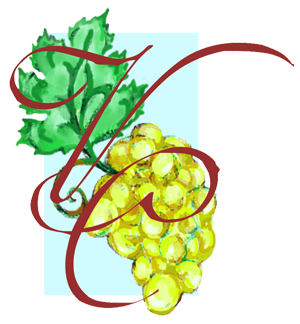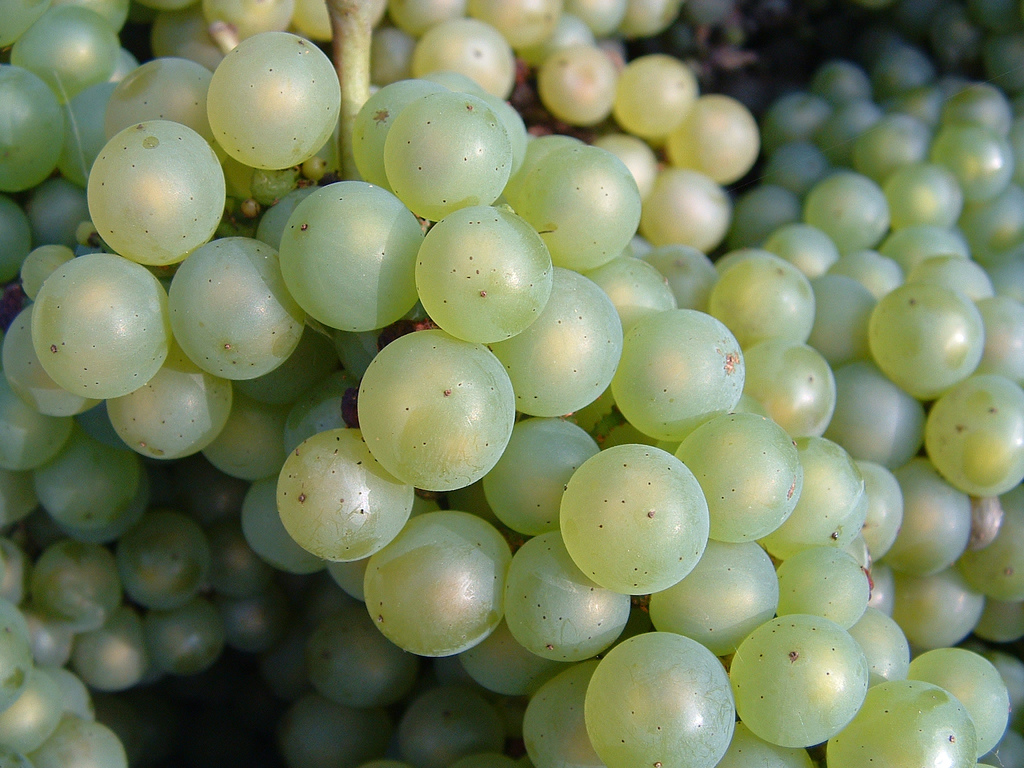Chardonnay (pronounced: [ʃaʁ.dɔ.nɛ]) is a green-skinned grape variety used in the production of white wine. The variety originated in the Burgundy wine region of eastern France, but is now grown wherever wine is produced, from England to New Zealand. For new and developing wine regions, growing Chardonnay is seen as a "rite of passage" and an easy entry into the international wine market.[1]
The Chardonnay grape itself is very neutral, with many of the flavors commonly associated with the grape being derived from such influences as terroir and oak.[2] It is vinified in many different styles, from the lean, crisply mineral wines of Chablis, France, to New World wines with oak, and tropical fruit flavors. In cool climates (such as Chablis and the Carneros AVA of California), Chardonnay tends to be medium to light body with noticeable acidity and flavors of green plum, apple, and pear. In warmer locations (such as the Adelaide Hills and Mornington Peninsula in Australia and Gisborne and Marlborough region of New Zealand), the flavors become more citrus, peach, and melon, while in very warm locations (such as the Central Coast AVA of California), more fig and tropical fruit notes such as banana and mango come out. Wines that have gone through malolactic fermentation tend to have softer acidity and fruit flavors with buttery mouthfeel and hazelnut notes.[3]
Chardonnay is an important component of many sparkling wines around the world, including Champagne. A peak in popularity in the late 1980s gave way to a backlash among those wine connoisseur who saw the grape as a leading negative component of the globalization of wine. Nonetheless, it remains one of the most widely planted grape varieties, with over 160,000 hectares (400,000 acres)[4] worldwide, second only to Airén among white wine grapes and planted in more wine regions than any other grape – including Cabernet Sauvignon.[1]
Chardonnay has a wide-ranging reputation for relative ease of cultivation and ability to adapt to different conditions. The grape is very "malleable", in that it reflects and takes on the impression of its terroir and winemaker. It is a highly vigorous vine, with extensive leaf cover which can inhibit the energy and nutrient uptake of its grape clusters. Vineyard managers counteract this with aggressive pruning and canopy management. When Chardonnay vines are planted densely, they are forced to compete for resources and funnel energy into their grape clusters. In certain conditions, the vines can be very high-yielding, but the wine produced from such vines suffers a drop in quality if yields go much beyond 4.5 tons per acre (80 hl/ha). Producers of premium Chardonnay limit yields to less than half this amount.[2] Sparkling wine producers tend not to focus as much on limiting yields, since concentrated flavors are not as important as the wine's finesse.
Harvesting time is crucial to winemaking, with the grape rapidly losing acidity as soon as it ripens. Some viticultural hazards include the risk of damage from springtime frost, as Chardonnay is an early-budding vine – usually a week after Pinot noir. To combat the threat of frost, a method developed in Burgundy involves aggressive pruning just prior to budburst. This "shocks" the vine and delays budburst up to two weeks, which is often long enough for warmer weather to arrive.[6] Millerandage and coulure can also pose problems, along with powdery mildew attacking the thin skin of the grapes.[2] Because of Chardonnay's early ripening, it can thrive in wine regions with short growing seasons, and in regions such as Burgundy, can be harvested before autumn rain sets in and brings the threat of rot.[5]
While Chardonnay can adapt to almost all vineyard soils, the three it seems to like most are chalk, clay, and limestone, all very prevalent throughout Chardonnay's traditional "homeland". The Grand crus of Chablis are planted on hillsides composed of Kimmeridgian marl, limestone, and chalk. The outlying regions, falling under the more basic "Petit Chablis" appellation, are planted on portlandian limestone which produces wines with less finesse. Chalk beds are found throughout the Champagne region, and the Côte-d'Or has many areas composed of limestone and clay. In Burgundy, the amount of limestone to which the Chardonnay vines are exposed also seems to have some effect on the resulting wine. In the Meursault region, the premier cru vineyards planted at Meursault-Charmes have topsoil almost 78 in (2.0 m) above limestone and the resulting wines are very rich and rounded. In the nearby Les Perrieres vineyard, the topsoil is only around 12 in (30 cm) above the limestone and the wine from that region is much more powerful, minerally, and tight, needing longer in the bottle to develop fully. In other areas, soil type can compensate for lack of ideal climate conditions. In South Africa, for example, regions with stonier, shaley soils and high clay levels tend to produce lower-yielding and more Burgundian-style wine, despite having a discernibly warmer climate than France. In contrast, South African Chardonnay produced from more sandstone-based vineyards tend to be richer and more weighty.[6]




